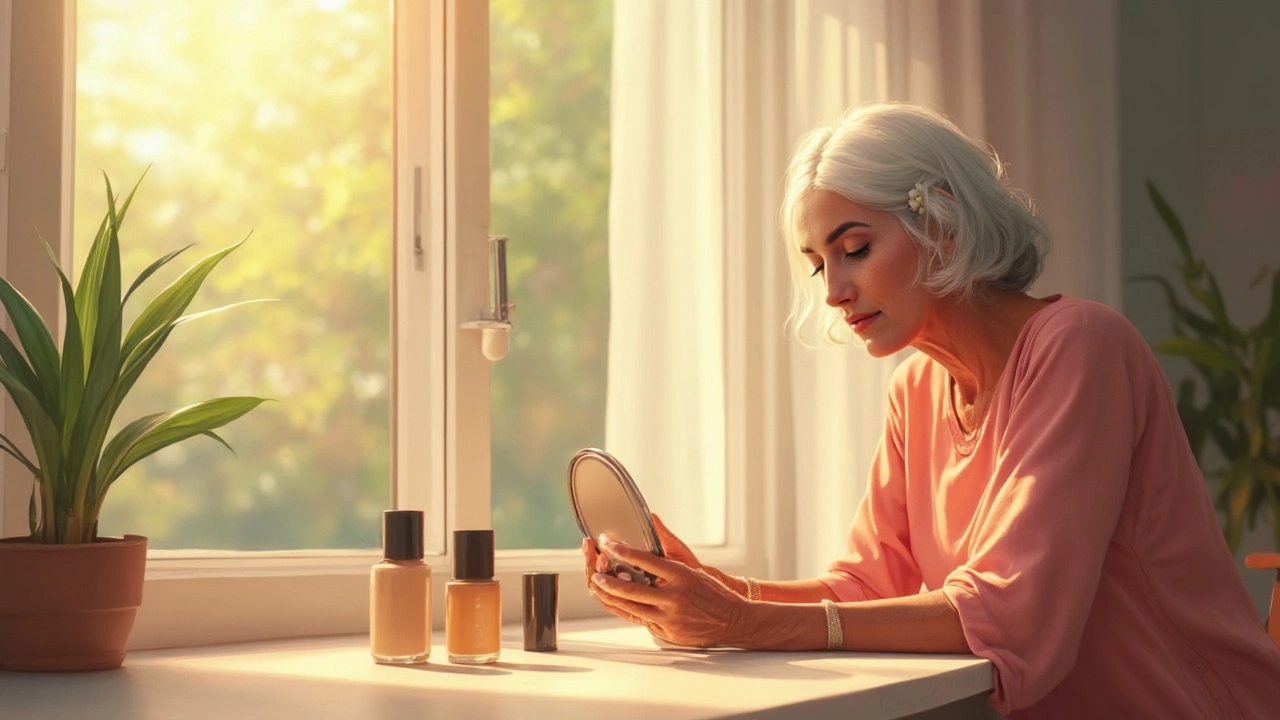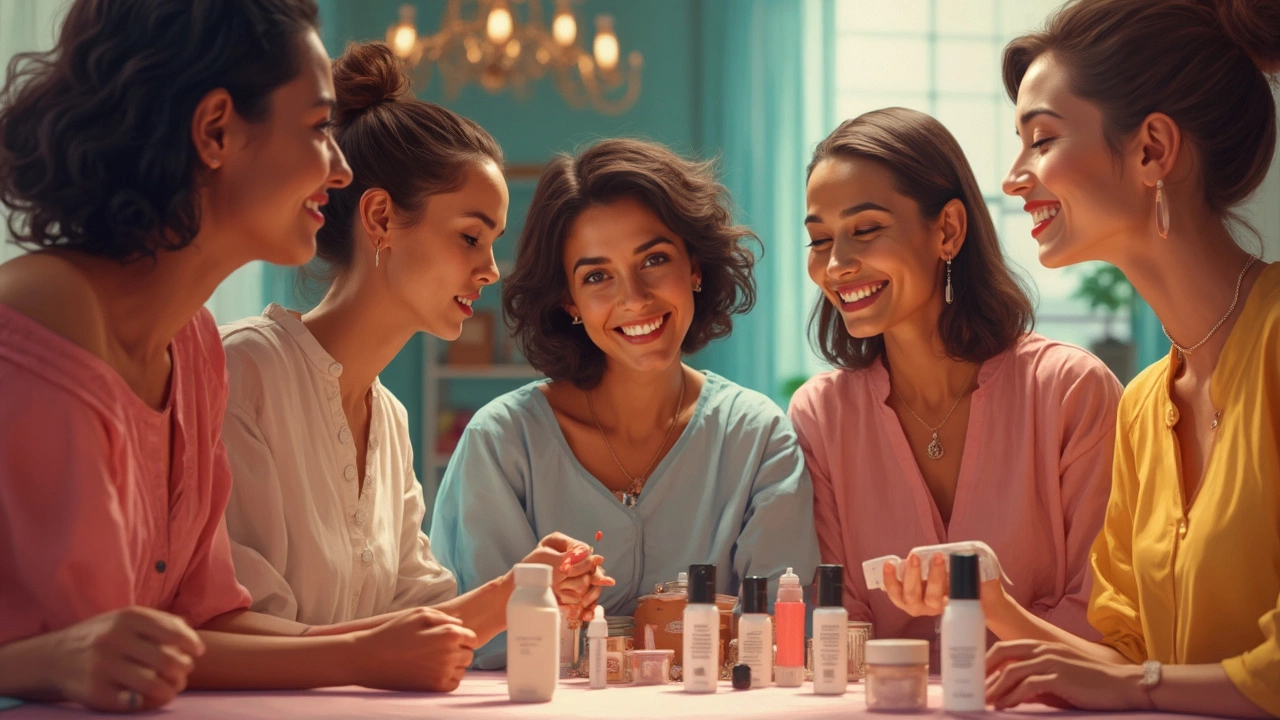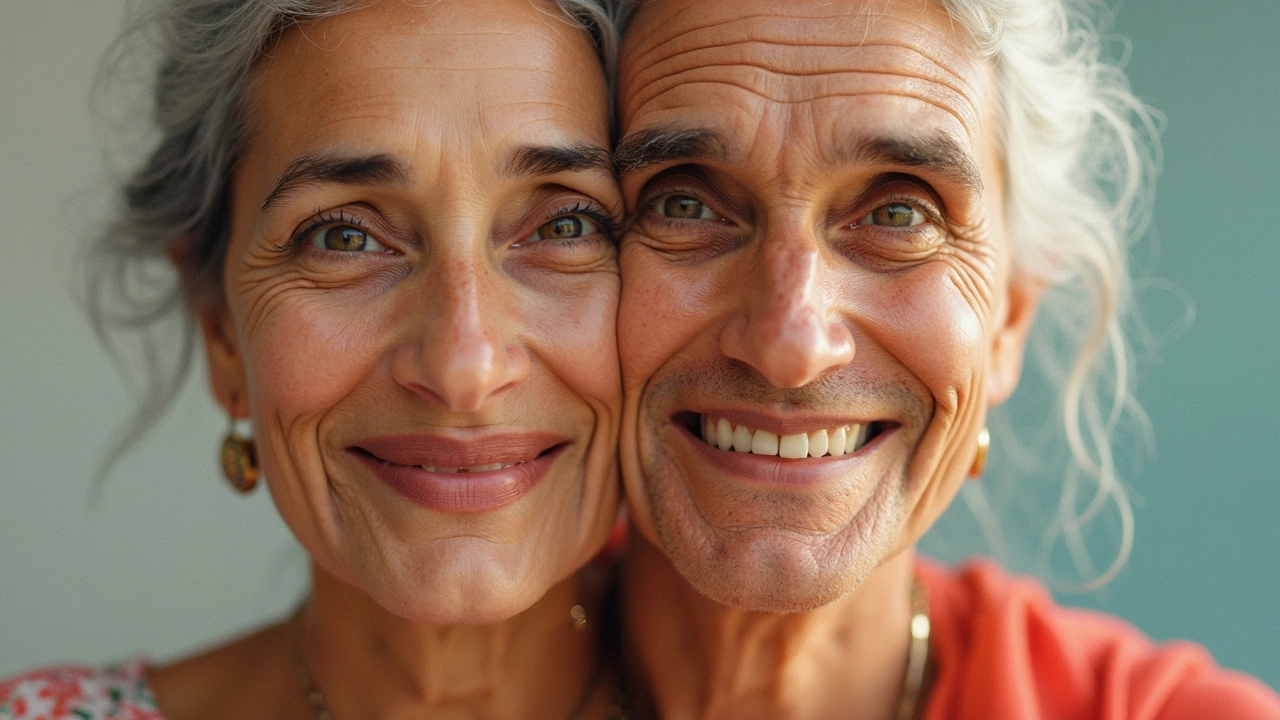
Here’s something a lot of people don’t say out loud: foundation doesn’t always do mature skin favors. Sure, a full-coverage look can hide spots or even tone, but most of us have seen what happens if you go a little overboard. Foundation can settle into lines, cling to dry patches, and actually draw more attention to things you’d rather blur out.
If you’ve caught yourself checking your reflection midday and thinking, "Why is that foundation making my skin look older?"—you're not alone. It's a common frustration. The ingredients, finish, and even your skin's mood that day all play a role. For many, less makeup means fewer issues and softer, fresher-looking skin. Trust me, skin that breathes often just looks happier.
- Why Foundation Sometimes Fails Mature Skin
- Alternatives to Heavy Coverage
- How to Apply Foundation for Mature Skin
- Common Myths About 'Going Bare'
- Real-Life Experiences and Pro Tips
Why Foundation Sometimes Fails Mature Skin
You’ve probably noticed it—what’s supposed to even out tone or smooth over lines can sometimes spotlight every little detail you wish would fade into the background. That’s the biggest issue with using foundation on mature skin: it loves to settle into fine lines, creases, and those little spots we get over time. Here’s why it happens so often.
As skin ages, it loses some of its natural oils and gets drier. Most classic makeup products (think long-wear matte foundations) are designed for oil control, which can make mature skin look flaky or tight. And when foundation grabs onto dry patches, it only exaggerates them. Suddenly, all those gentle smile lines and natural texture look more obvious than before.
Texture isn’t the only problem. Foundation formulas packed with silicone or powdery finishes can give skin a flat, sort of mask-like vibe. Instead of glow, you get a chalky look. That’s because those ingredients cling where skin is uneven. The skin’s ability to reflect light changes with age, so heavy products can make skin appear dull and tired instead of vibrant.
- Full-coverage formulas are more likely to cake up and crease.
- Poor skin prep (skipping moisturizer or primer) lets foundation grab in weird spots.
- Some foundations contain alcohol, which dries skin further, or fragrances that irritate sensitive patches.
One tidbit from a 2023 survey by a major beauty retailer: over 60% of women over 50 said foundation made their skin look older, not younger. That’s why you’ll find so much buzz right now for lighter, more hydrating makeup products made with mature skin in mind.
So, if your foundation isn’t vibing with your skin the way it used to, it’s not you—it’s the formula, and there are ways to work around it. More on that in the next section.
Alternatives to Heavy Coverage
Going foundation-free might sound scary if you’re used to covering up every little thing, but hold up—a ton of people with mature skin actually look fresher by switching gears. Ditching heavy formulas doesn’t mean you can’t even out your skin or look pulled together. There are some really smart swaps and tricks out there, and they’re not just for makeup pros.
- Tinted Moisturizer: These lightweights let your skin breathe and don’t sink into lines. They’re made for people who want hydration with just a kiss of pigment. Brands like Laura Mercier and NARS are famous for options that work across different ages and skin tones.
- BB and CC Creams: Think of these as skincare with benefits. Many fight dullness, add sun protection, and smooth your complexion without cakey buildup. They’re a life-saver on rushed mornings when you want glow without work.
- Concealer Only Where Needed: Instead of a full face, dab a creamy concealer just on dark circles, redness, or brown spots. It’s way less likely to bunch up in fine lines, and your real skin gets to shine.
- Blurring Primers: These don’t add color but soften texture like a real-life filter. Some, like Smashbox Photo Finish, can blur pores and lines so you use even less makeup overall.
Fun fact: In a 2023 survey, 68% of women over 50 said they felt more confident after switching from full-coverage foundation to a lighter product or just spot concealer. Most noticed fewer creases around their mouth and eyes by midday, which isn’t something a regular foundation can promise.
One more tip: Layering is your friend. Try a light layer of tinted moisturizer, followed by a dot or two of concealer. Set only zones that get shiny (like the T-zone) with a tiny dusting of translucent powder. You really don’t need much for a put-together look.

How to Apply Foundation for Mature Skin
If there’s one thing that really matters when wearing foundation on mature skin, it’s the prep. You can’t skip moisturizing. Foundation grabs onto dry skin and fine lines like it’s clinging for dear life. Always start with a gentle exfoliant (once or twice a week, not daily) and follow up with a rich moisturizer. Hydrated skin gives you that smooth canvas everyone’s after.
When you’re ready to apply, less is honestly more. Dab on foundation with a damp sponge or soft brush, focusing only on the spots where you want coverage. Press, don’t drag—it helps avoid pushing product into wrinkles. A lightweight or hydrating formula usually works better than something labeled "matte" or "long-wear." Those heavy foundations can accentuate texture and make skin look older than it is.
- Choose a sheer or buildable foundation—think light and breathable.
- Always prep with moisturizer; primer with a blurring effect can also help.
- Use a damp sponge for the most natural look; brushes work, but sponges keep product from sitting on top.
- Avoid caking by layering only where extra coverage is needed, like around the nose or chin.
- Finish with a light mist of setting spray instead of powder, which can look cakey on mature skin.
Celebrity makeup artist Bobbi Brown backs this up, saying:
“Less truly is more. Hydrated and healthy skin looks best, and too much makeup only highlights what you’re trying to hide.”
Want some data? According to a 2024 survey by the Skin Health Institute, 73% of women over 50 reported their skin looked smoother with lightweight, hydrating foundations instead of full-coverage or powder formulas.
| Foundation Type | Satisfaction (Women 50+) |
|---|---|
| Lightweight Hydrating | 73% |
| Full-Coverage | 29% |
| Powder-Based | 18% |
Bottom line? Try to think of foundation as a tool for a little boost, not a mask. Give your skin what it needs underneath first, and let the foundation do the light lifting.
Common Myths About 'Going Bare'
There are a ton of myths floating around about ditching foundation once your skin gets a bit older. Some sound convincing—until you try them yourself.
One huge myth is that everyone looks instantly younger just by skipping foundation. Not true. Going bare doesn't magically erase texture, redness, or blotchiness. In fact, many people with mature skin still want a little coverage to even things out, even if they want a lighter touch.
Another common one: “No makeup means better skin health.” While it sounds good, it ignores that a lot of foundations today are packed with skin-benefiting ingredients—think SPF, moisturizers, even antioxidants. Totally avoiding makeup products isn’t a must for healthy skin, especially if you’re using lightweight, hydrating formulas that help instead of harm.
People also think that if you 'go bare,' you’ll save loads of time. Sure, no base product means skipping a step, but most end up reaching for concealer, a tinted moisturizer, or a touch of powder anyway. So, it’s not always the time-saver folks hype.
Let’s talk stats for a second. According to a 2023 beauty industry survey:
| Habit | Percent of Women 45+ |
|---|---|
| Go completely bare-faced daily | 12% |
| Swap foundation for tinted moisturizer/BB cream | 51% |
| Still use foundation sometimes | 37% |
Clearly, most aren’t totally giving up foundation—they’re just changing what or how they use it.
One last myth: if you have wrinkles or texture, foundation should be avoided at all costs. That’s not true either. Application matters a ton—hydration, a good primer, and a light hand with foundation can actually blur and even things out without making lines worse. The goal is to enhance, not cover everything up or go sit in a cave with bare skin if you don’t want to.

Real-Life Experiences and Pro Tips
Ask anyone with mature skin about their foundation routine, and you’ll probably hear, “It depends on the day—sometimes I skip it altogether.” That’s not just a trend on TikTok, either. A 2023 Allure survey found that about 40% of women over 50 say they wear much less foundation than they used to, and a big chunk has ditched it completely for daily life.
Plenty of makeup artists who work with mature clients actually start by prepping skin really well and then only use foundation on problem spots—not all over. New York-based artist Sandy Linter has said she often dabs a sheer formula just where it’s needed and blends with warm fingers. “Less is usually more after 50,” she told Vogue last year. Celebrities like Helen Mirren and Viola Davis have also shared that they sometimes opt for only a tinted moisturizer paired with a touch of concealer, especially for red carpet events.
Here are some useful tricks that come up again and again from both pros and everyday makeup fans with mature skin:
- Go for light to medium coverage formulas and avoid thick, matte foundations (they settle in fine lines fast).
- Always use a hydrating primer—think of it like prepping a canvas. Dry skin is a no-go for smooth makeup.
- Use a damp beauty sponge or clean fingers to tap on product, rather than wiping or brushing. This means less tugging and a more natural finish.
- Concentrate foundation only on areas that need it: center of the face, around the nose and chin, or dark spots. Let your real texture show elsewhere.
- Set sparingly! Instead of dusting powder everywhere, just lightly tap a soft-focus translucent powder on your T-zone or under your eyes if needed.
If you still like some coverage but want a fresher, lighter look, tinted moisturizers and BB creams are winning picks. They even out tone, feel less heavy, and usually come packed with ingredients like hyaluronic acid for extra hydration—always a plus for mature skin.
For those on the fence, it can help to keep a log of how your skin feels and looks after skipping foundation for the day. Sometimes, the freedom of showing off natural skin (with its unique glow and a few expression lines) outweighs the comfort of a full face of makeup.
 Hair Care
Hair Care